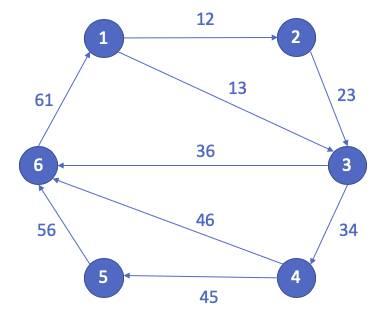A graph in Kafka Graphs is represented by two tables from Kafka Streams, one for vertices and one for edges. The vertex table is comprised of an ID and a vertex value, while the edge table is comprised of a source ID, target ID, and edge value.
KTable<Long, Long> vertices = ...
KTable<Edge<Long>, Long> edges = ...
KGraph<Long, Long, Long> graph = new KGraph<>(
vertices,
edges,
GraphSerialized.with(Serdes.Long(), Serdes.Long(), Serdes.Long())
);For example, in the class TestGraphUtils we define the following graph
-
Its
vertexare defined by:1,1 2,2 3,3 4,4 5,5 6,6 -
Its
edgesare defined by:1,2,12 1,3,13 2,3,23 3,4,34 3,6,36 4,5,45 4,6,46 5,6,56 6,1,61
Kafka Graphs provides a number of APIs for transforming graphs in the same manner as Apache Flink Gelly and Apache Spark GraphX.
- Filtering methods
filterOnEdgesfilterOnVerticessubgraph
- Joining methods
joinWithEdgesjoinWithEdgesOnSourcejoinWithEdgesOnTargetjoinWithVertices
- Mapping methods
mapEdgesmapVertices
- Reducing methods
groupReduceOnEdgesgroupReduceOnNeighborsreduceOnEdgesreduceOnNeighbors
- Transforming methods
inDegreesoutDegreesundirected
For example, the following will compute the sum of the values of all incoming neighbors for each vertex.
graph.reduceOnNeighbors(new SumValues(), EdgeDirection.IN);In the class GraphOperations we run the Operations over the defined Graph
-
The method
testOutDegrees()Calculates
KTable<Long, Long> outDegrees = graph.outDegrees();The result is the out-degree of each vertex:
1,2 2,1 3,2 4,2 5,1 6,1 -
The method
testInDegrees()Calculates
KTable<Long, Long> inDegrees = graph.inDegrees();The result is the in-degree of each vertex:
1,1 2,1 3,2 4,1 5,1 6,3 -
The method
testUndirected()Calculates
KTable<Edge<Long>, Long> data = graph.undirected().edges();The result is the all the edges without considering direction:
1,2,12 2,1,12 1,3,13 3,1,13 2,3,23 3,2,23 3,4,34 4,3,34 3,6,36 6,3,36 4,5,45 5,4,45 4,6,46 6,4,46 5,6,56 6,5,56 6,1,61 1,6,61 -
The method
testSubGraph()Calculates
KTable<Edge<Long>, Long> data = graph.subgraph((k, v) -> v > 2, (k, e) -> e > 34).edges();The result is all the edges with vertex greater than 2 and edge greater than 34:
3,6,36 4,5,45 4,6,46 5,6,56 -
The method
testFilterVertices()Calculates
KTable<Edge<Long>, Long> data = graph.filterOnVertices((k, v) -> v > 2).edges();The result are all the vertex greater that 2:
3,4,34 3,6,36 4,5,45 4,6,46 5,6,56 -
The method
testFilterEdges()Calculates
KTable<Edge<Long>, Long> data = graph.filterOnEdges((k, e) -> e > 34).edges();The result are all the edges greater than 34:
4,5,45 4,6,46 5,6,56 6,1,61
